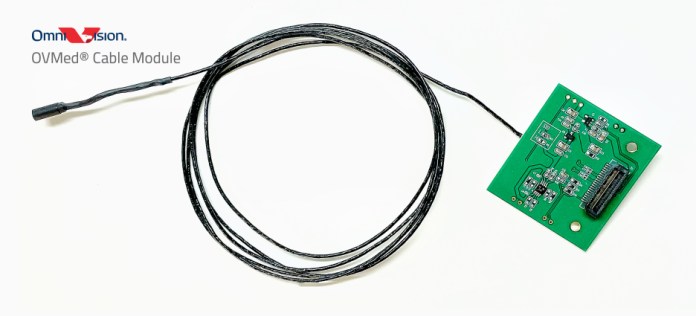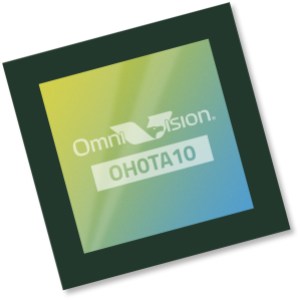Imaging subsystems and camera modules are emerging in the medical device market to help OEMs accelerate time to market, enabling them to focus on differentiating their product designs. This is thanks in part to advances in processes and architectures of CMOS image sensors, which are delivering high sensitivity and signal-to-noise ratio (SNR) as well as low power consumption.
It is also related to the medical industry’s move from reusable to disposable endoscopes. The market is changing from a reusable to disposable product business model, said Yole Intelligence, part of Yole Group. Disposable and capsule endoscopy solutions, which are designed to be discarded after use, are delivering low-cost benefits and eliminating cross-contamination and the need for reprocessing, said the market analyst firm.
When selecting an image sensor, designers need to pay attention to key specs like optical format (sensor size) and dynamic range, as well as other factors like optics, thermal management, and power consumption. At the same time, they face issues around design complexity.
In addition to the need for improving diagnostic accuracy, which requires high image quality, these image sensor solutions also need to shrink for the disposable endoscope market. At the same time, image sensor manufacturers also need to address issues around design complexity and integration.
To address these concerns, a few image sensor manufacturers have developed integrated imaging subsystems along with smaller camera modules. A couple of examples include ams OSRAM’s NanEyeM camera module and Omnivision’s OVMed OCHSA and OCHTA cable modules and CameraCubeChip camera module.
Image sensor manufacturers say it takes time and cost to source and procure the cables and LEDs and then pair with wafer-level modules. With a complete imaging subsystem for endoscopes, it shortens time to market for the designers while allowing doctors to see more detail in the body’s smallest anatomy.
NanEyeM camera module
Within the past year, ams OSRAM has expanded its NanEye portfolio with the NanEyeM camera module for single-use medical endoscopy. It is a packaged digital endoscopy camera module, including the cable, offering high resolution and a small size.
With its small dimensions of 1 × 1 × 2.7 mm, the module can be used in areas with size restrictions, such as single-use applications in bronchoscopy, urological endoscopy, or endoscopic procedures in the kidney. In endoscopic procedures, such as bronchoscopy, the transition from reusable to disposable devices has been accelerated by the Covid-19 pandemic, which has increased demand for disposable bronchoscopes, said ams OSRAM.
The NanEyeM module uses a “chip on tip” approach, whereby the image sensor and the optics are placed at the tip of the device (distal end) instead of at the other (proximal) end, which results in better image quality, according to the company.
The NanEyeM is a fully integrated imaging module, which uses wafer level multi-element optics to deliver high-quality images for high performance at close ranges. The lens features a wide field of view with an extended depth of field, which reduces distortions while delivering accurate images.
Other key features include a digital low-voltage differential-signaling serial interface with a high SNR, enabling the camera to transmit over long lengths of cable without loss of signal integrity or increase in noise, and a frame rate of up to 49 frames per second (fps) at a 320 × 320 resolution, for a low-delay display over a range of standard interfaces, while still providing low power consumption.
The image sensor also provides high sensitivity, so less illumination is required, said ams OSRAM. This helps keep the heat generation on the tip of the device under control, said the company. It features a 102.4-Kpixel resolution with a 2.4-µm highly sensitive pixel.
The module also comes with a cable that can be customized up to 3 meters in length, which also helps save on cost. Other benefits cited include a fully digital output, which eliminates the cost of an external analog-to-digital converter because this is done on-chip, and less susceptibility to magnetic interference from medical devices in the surgical environment (EMI/EMC), eliminating the need for coax or shielded cables.

The pre-attached cable of the NanEyeM enables easy integration into the endoscope while reducing cost. (Source: ams)
OVMed OCHSA and OCHTA cable modules
Omnivision’s OVMed OCHSA and OCHTA cable modules are designed for single-use endoscopes and catheters. They are fully tested and integrated medical-grade imaging subsystems with a small-diameter camera module, cables, and mini-LED illumination.
The company said this is the first commercially available integrated mini-LED illumination for single-use endoscopy, and it provides precise brightness control, enabling surgeons to visualize anatomies that they couldn’t before. Key features include a higher contrast ratio in a smaller local area for small package sizes. It provides individual brightness and dimming control for multi-spectrum (RGB/IR) devices in surgical procedures.
The cable modules incorporate the company’s CameraCubeChip wafer-level 0.65 × 0.65-mm camera module. It delivers 400 × 400, or 160-KPixel, resolution for high quality images. They also feature the OVMed cables in a thin micro-coaxial form factor.
Two cable module options are available. The OCHSA cable module offers 800 × 800 pixel resolution with a high-speed MIPI digital interface for larger outer-diameter endoscopes, such as the bronchoscope, thoracoscope, pleuroscope, mediastinoscope, duoendoscope, and aminoscope. They can be customized and handle both short (2.5 meters or less) and long (up to 5 meters) distances.
The OCHTA cable module with an analog output integrates Omnivision’s OH0TA image sensor, which is smaller and offers quadruple the resolution of its predecessor. The cable module provides wafer-level optics in a single assembly. Due to its small size, it enables endoscopic devices to reach deeper into the body and can be used for a range of procedures, including neuro, ophthalmic, ENT, cardiac, spinal, urology, gynecology, and arthroscopy procedures. They can also be used in dental and veterinary applications.
The OVMed cable modules undergo certification, qualification, and testing, including testing for banned substances, sterilization, biocompatibility, workmanship, operational tests, and stress tests. This increases the likelihood and speed of FDA certification for medical device OEMs, said Omnivision. An evaluation kit with a pretested OVMed image signal processor is available.

The OVMed cable modules are fully tested and integrated medical-grade imaging subsystems with cables and mini-LED illumination. (Source: Omnivision)

The OH0TA OVMed medical image sensor features a package size of 0.55 × 0.55 mm. (Source: Omnivision)
The OH0TA OVMed CMOS image sensor, housed in a package size of 0.55 x 0.55 mm, features a 1.0-µ pixel and a 1/31-inch optical format. Compared with its predecessor, the OH0TA quadruples the RGB image resolution to 400 × 400, or 160 Kpixels, at 30 fps while reducing the power consumption by 20% to 20 mW. This allows improved imaging for single-use and reusable endoscopes, as well as catheters and guidewires, with a small outer diameter of 1–2 mm, said Omnivision.
The company attributes the improved resolution along with a smaller pixel size and optical format to its PureCel Plus-S stacked-die technology. This pixel technology is said to provide higher color fidelity, excellent low-light sensitivity of 3,600 mV/lux-sec, and a high SNR of 37.5 dB for crisper images. Other benefits include a higher full-well capacity, zero blooming, and lower power consumption.
Omnivision also introduced 8-MP resolution sensors — the OH08A and OH08B — last year, claiming the first for single-use and reusable endoscopes. The OH08B is also the first medical-grade image sensor to use the company’s Nyxel near-infrared (NIR) technology.
The OH08A/B 8-MP image sensors target endoscopes with a 10- to 12-mm outer diameter, such as gastroscopes, duodenoscopes, amnioscopes, laparoscopes, and colonoscopes, delivering higher image quality, up to 4K2K resolution at 60 fps. The OH08B with Nyxel technology is said to deliver better performance in color and IR sensitivity for sharper video during NIR, fluorescence, chromo-endoscopy, and virtual endoscopy procedures.
Nyxel technology provides 3× quantum efficiency improvement at both the 850-nm and 940-nm NIR wavelengths, said Omnivision, which also allows the use of lower-power IR illumination for significantly reduced chip-on-tip power consumption.
Advertisement
Learn more about ams (formerly austriamicrosystems)OmniVision Technologies






